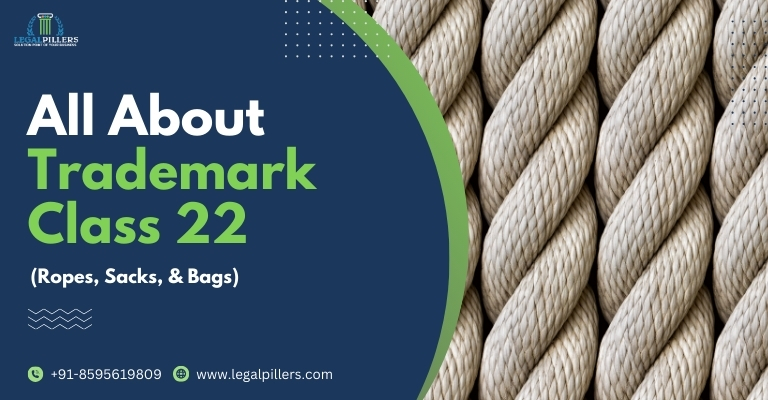
Table of Contents
All About Trademark Class 22
Trademark Class 22 is a category under the Nice Classification system, which is used to classify goods and services for trademark registration purposes. Class 22 primarily includes products made from various types of fibres and textiles, as well as certain materials used for packaging and bundling, such as ropes, cordage, nets, and tents. It encompasses a wide range of items related to textiles, textile goods, and similar materials, making it an important class for businesses involved in manufacturing, selling, or distributing these types of products. When seeking trademark protection for goods falling under Class 22, it is essential to ensure that the mark is distinctive and not already in use for similar products to prevent confusion among consumers.
Important goods included in Trademark Class 22
Trademark Class 22 mainly includes canvas and other materials for making sails, rope, padding, cushioning, and stuffing materials and raw fibrous textile materials. The goods included in this trademark class are as given below:
- Cords and twines made of natural or artificial textile fibres, paper or plastics.
- Commercial fishing nets, hammocks, rope ladders
- Vehicle covers, not fitted
- Certain sacks and bags not otherwise classified by function or purpose, for instance, mesh bags for washing laundry, body bags, mail bags
- Packaging bags of textile
- Animal fibres and raw textile fibres, for example, animal hair, cocoons, jute, raw or treated wool, raw silk
Goods does not included in Trademark Class 22
- Metal ropes (included in class 6)
- Strings for musical instruments (included in class 15)
- Strings for sports rackets (included in class 28)
- Padding and stuffing materials of paper or cardboard (included in class 16)
- Padding and stuffing materials of rubber or plastics (included in class 17)
- Certain nets and bags that are classified according to their function or purpose, for instance,-
- Safety nets (included in class 9)
- Luggage nets for vehicles (included in class 12)
- Garment bags for travel (included in class 18)
- Hair nets (included in class 26)
- Golf bags (included in class 28)
- Nets for sports (included in class 28)
- Packaging bags, not of textile, which are classified according to the material of which they are made, for example,-
- Packaging bags of paper or plastics (included in class 16)
- Packaging bags of rubber (included in class 17)
- Packaging bags of leather (included in class 18)
List of popular examples of Trademark Class 22
- Black Diamond: Tents, stuff sacks, climbing ropes.
- Coleman: Tarpaulins and tents
- White Mountain: Packing string, string, nets, tarpaulins, raw fibrous textile
- Tent Mart: Tents, kannats, pandals, ceilings, mandaps, tarpaulins, and other tent-related items.
List of goods classified under Trademark Class 22
A
- Animal feeding nets
- Animal hair
- Awnings of textile
- Awnings of synthetic materials
B
- Bags [envelopes, pouches] of textile, for packaging
- Binding thread, not of metal, for agricultural purposes
- Bindings, not of metal
- Bivouac sacks being shelters
- Body bags
- Braces, not of metal, for handling loads/harness, not of metal, for handling loads
- Brattice cloth
C
- Cables, not of metal.
- Camel hair
- Camping swags
- Canvas for sails
- Car towing ropes
- Carbon fibers [fibres] for textile use
- Carded wool
- Cloth bags specially adapted for the storage of diapers
- Coconut fiber [fibre]
- Cocoons
- Combed wool
- Commercial fishing nets
- Cords for hanging pictures
- Cotton tow
- Cotton waste [flock] for padding and stuffing
- Covers for camouflage
D
- Down [feathers]
- Dust sheets/ drop cloths
E
- Eiderdown
- Esparto grass
F
- Feathers for bedding
- Feathers for stuffing upholstery
- Fleece wool
- Flock [stuffing]
G
- Glass fibers [fibres] for textile use
- Grasses for upholstering
H
- Hammocks
- Hemp fibers [fibres]
- Hemp bands
- Horsehair
J
- Jute
K
- Kapok
L
- Ladder tapes for jalousies or webbing for jalousies
- Liber
- Linters
M
- Mail bags
- Mesh bags for washing laundry
N
- Net pens for fish farming
- Nets for camouflage
- Nets*
- Netting for protection against birds and insects
O
- Outdoor blinds of textile
P
- Packing [cushioning, stuffing] materials, not of rubber, plastic, paper, or cardboard
- Packing string
- Packing rope
- Padding materials, not of rubber, plastics, paper, or cardboard/ stuffing materials, not of rubber, plastics, paper, or cardboard.
- Pig bristles
- Plastic fibers [fibres] for textile use
- Purse seines
R
- Raffia
- Ramie fibre [fiber]
- Raw cotton
- Raw fibrous textile
- Raw or treated wool
- Raw silk
- Rockfall prevention nets, not of metal
- Rope ladders
- Ropes, not of metal.
- Ropes*
S
- Sacks for the transport and storage of materials in bulk
- Sail gaskets
- Sails
- Sails for ski sailing
- Sash cords
- Sawdust
- Schappe [raw silk waste] or silk waste
- Seaweed for stuffing
- Sheaf-binding yarns
- Shorn wool
- Silk flock
- Sisal
- Slings, not of metal, for handling loads
- Snares [nets]
- Soy foam for padding and stuffing
- Straps, not of metal, for handling loads/ belts, not of metal, for handling loads
- Straw for stuffing upholstery
- Straw wrappers for bottles/bottle envelopes of straw/packing, of straw, for bottles
- String
- Strips for tying up vines
T
- Tarpaulins
- Tents
- Textile fibres [fibers]
- Thread, not metal, for wrapping or binding
- Tow
- Twine made of paper
- Twine for nets
U
- Upholstery wool [stuffing]
V
- Vehicle covers [not fitted]
- Vitreous silica fibers [fibres] for textile use
W
- Wadding for filtering
- Wadding for padding and stuffing upholstery
- Wax ends
- Whipcord
- Wood shavings for stuffing
- Wood wool
- Wool flock
- Wrapping or binding bands, not of metal
Z
- Zip ties/ cable ties, not of metal
Conclusion
Trademark Class 22 plays a crucial role in the world of trademark registration, focusing on goods related to textiles and flexible materials used in various industries. This class encompasses a wide range of products, including textiles, bags, sacks, and even nets and tents. By registering their trademarks in Class 22, businesses can secure exclusive rights to their brand identity within this specific category, ensuring protection for their textiles and flexible materials-related products. Properly classifying trademarks under Class 22 is essential for legal protection and compliance with trademark laws and regulations, especially for those operating in industries where textiles and flexible materials are fundamental components.
LegalPillers is here to help you for navigating the complexities related to the classification & registration of the trademark, making sure that your band has been safeguarded within this trademark class.
(FAQs) about Trademark Class 22
What is Trademark Class 22?
● Trademark Class 22 is one of the 45 classes established by the Nice Classification system for trademark registration, specifically focusing on goods related to textiles and flexible materials.
What types of goods are included in Class 22?
● Class 22 includes goods such as textiles, textile goods, bags, sacks, and flexible materials, including nets and tents.
Why is Class 22 important for businesses?
● Class 22 is crucial for businesses dealing with textiles and flexible materials, as it provides a dedicated category for trademark registration, ensuring exclusive rights to their trademarks within this specific domain of goods.
Can a trademark be registered in multiple classes, including Class 22?
● Yes, a trademark can be registered in multiple classes if the business deals with goods or services from different categories, offering broader protection.
How do I determine if my product falls under Class 22?
● To accurately classify your product, consult with a trademark attorney or use the Nice Classification system.
Is clothing included in Class 22?
● No, clothing items, including apparel, are typically categorized under Trademark Class 25.
Do they belong to Class 22?
● No, leather bags are generally classified under Trademark Class 18.
Can I trademark a brand name and logo separately in Class 22?
● Yes, you can trademark a brand name, logo, or both within Class 22, depending on your specific needs.
Is there a specific duration for trademark protection in Class 22?
● Trademark protection typically lasts for 10 years initially and can be renewed indefinitely as long as you continue to use and renew it.
Can I change the class of my trademark registration later if needed?
● Changing the class of a trademark registration can be complex, so it is advisable to consult with a trademark attorney.
Are there any restrictions on the use of trademarks in Class 22?
● Trademarks in Class 22 must be used for the specified goods in that class to maintain their validity.
What is the process for resolving trademark disputes in Class 22?
● Trademark disputes in Class 22 are typically resolved through legal actions, negotiations, or trademark cancellation proceedings, depending on the circumstances.
Are there specific regulations or certifications associated with Class 22 goods?
● Depending on the jurisdiction and the specific goods, there may be regulatory requirements or certifications related to safety and quality standards for textiles and flexible materials.
Can I trademark a name for my textile brand under Class 22?
● Yes, you can trademark the name of your brand associated with textiles and flexible materials within Class 22.
Is it advisable to consult with a trademark attorney when registering a trademark in Class 22?
● Yes, consulting with a trademark attorney is highly recommended to ensure proper classification, registration, and protection of your trademark in Class 22. They can provide valuable guidance throughout the process.
What are some examples of goods made from flexible materials in Class 22?
● Examples include nets, tents, tarps, bags, and sacks made from flexible materials.
Can I register a trademark for both textile goods and tents under Class 22?
● Yes, you can register a trademark that covers a variety of goods within Class 22, including both textile goods and flexible materials like tents, as long as they fall within the class scope.
Is there an international standard for Class 22 trademarks?
● Yes, the Nice Classification system provides an international standard for classifying trademarks, making it easier for businesses to protect their brand internationally.
Can I trademark a brand for both bags and textile goods under Class 22?
● Yes, you can register a trademark that covers a range of goods within Class 22, including bags and textile products, as long as they fall within the class scope.
Is there a specific scope of products that fall under Class 22, or is it broad?
● Class 22 covers a broad range of goods related to textiles and flexible materials, making it a versatile class for businesses in these industries to protect their brand identity.



Leave a Reply